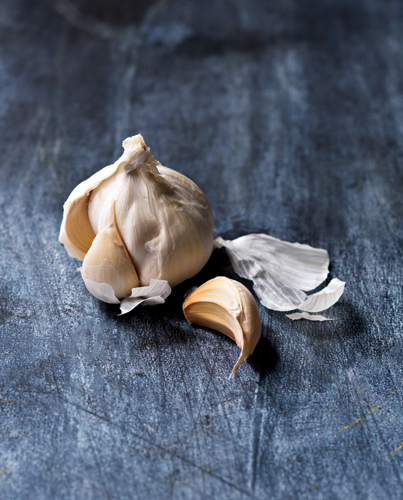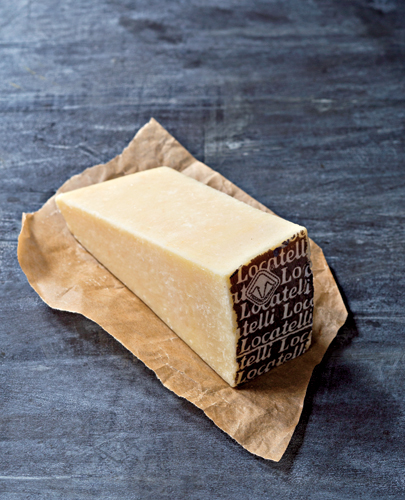PANTRY
SALT: MORTON TABLE SALT. The girl with the umbrella. Some salt isn’t as salty as other salt because of the iodization process, and this is the saltiest one. When we make our dough over at Artichoke, we always use Morton’s. Sysco tried sellin’ us a cheaper salt, but it just wasn’t as good. We know it’s fashionable to cook with sea salt and kosher salt and stuff like that, and maybe it’s healthier. But for our recipes, it’s mostly Morton’s.
OLIVE OIL: FILIPPO BERIO. It’s the one we know and the one we like, but you could go with any other brand that tastes good to you. Just look for one that doesn’t say “extra virgin.” It’s important to know the difference between the types of olive oil available, because it really affects the flavor. The very first press of the olives is extra virgin, the second is virgin, and the third is what’s called pomace. That’s the one you’re lookin’ for—one that doesn’t say “extra virgin” or “virgin” on the label, just “olive oil.” It doesn’t have the strong, almost bitter flavor of extra virgin, which can get in the way of a dish. If you fry something in extra-virgin olive oil or use it to make a sauce, that’s all you’re gonna taste. Plus, it’s expensive. You can buy a gallon of pomace for like ten bucks. Save the extra-virgin stuff for things like dressin’ a salad or dippin’ bread. All the recipes in this book are made using pomace unless otherwise noted.
BUTTER: BREAKSTONE’S. All the way. And always salted. It’s what we had growin’ up, and to this day, if there’s toast, it’s got Breakstone’s on it. We like the way it tastes and we like the way it melts. All the recipes in this book call for salted butter unless otherwise noted.
PASTA: RONZONI. It’s what we’ve always bought and what we’re used to. Though frankly, as far as dried pasta goes, it’s just about the same from brand to brand. It’s pretty much all packed in the same place. As for dry versus fresh, we personally prefer dry pasta. It’s not as doughy, and you can keep it in the cabinet for five years—it’ll never go bad. Having said that, you gotta go fresh for tortellini and ravioli because of the fillings. We use Pastosa, a Staten Island institution that distributes around the country. We’re not just fans because they’re locals—we’ve yet to find a better fresh pasta.
TOMATOES: REDPACK AND TUTTOROSSO. These are the best, and it doesn’t hurt that our good friend’s father owns the company. Don’t be fooled by all the San Marzano nonsense. San Marzano is a region of Italy that supposedly has the best soil and weather for growin’ tomatoes. But our friend’s father will tell you that it’s a load of bull. A lotta these companies are just buyin’ tomatoes in California and passin’ ’em off as San Marzano. So the way to find the best tomatoes is to go with the ones that taste the best to you, whether they’re from Italy, California, or New Jersey.
GOOD ITALIAN BREAD: Look for one that’s crusty on the outside, not soft. It’ll stay good for two days, tops. Eat it fresh on day one, butter and toast it the next, then turn it into bread crumbs or Italian French Toast (here) after that.
PECORINO AND PARMIGIANO-REGGIANO: The two heavyweight champions of cheese. And we use Pecorino Romano, but any pecorino is good. We recommend buying your cheese in hunks, ungrated. But if you’d rather buy it grated, you don’t want the Kraft product that looks like a can of Ajax. You want one that’s in the deli section, ideally grated that day.
THE REST:
All-purpose flour
Anchovies
Black pepper (pre-ground is okay)
Bouillon cubes
Bread crumbs (see our recipes here and here)
Canned beans (cannellini and chickpea)
Chicken stock
Dried parsley
Garlic
Onions
Oscar Mayer bacon
Red pepper flakes
Rice
Tomato paste
Tomato puree

EQUIPMENT
NICE, BIG POT—Make that two, so you can be makin’ sauce in one and boilin’ macaroni in the other. They’ve gotta be a good, heavy gauge, especially for when you’re cookin’ sauce for hours. If it’s a cheap pot, you’re gonna burn the sauce.
FRYIN’ PANS—The kind you smack somebody in the head with. You want ’em nice and heavy, like cast iron or stainless steel. Heavy metal absorbs and distributes the heat more evenly, like the way a pizza oven works. With a cheap pan, you only get hot spots where the heat is hittin’ the pan. When you’re fryin’ meatballs or cauliflower fritters, you don’t want to have to be moving things around to get into those hot spots.
GOOD CHOPPIN’ KNIFE—One with a little bit of weight to it.
TONGS—You gotta have tongs. Use ’em to turn things in the oven and on the grill, flip things that are fryin’, you name it.
CUTTING BOARD—For choppin’ garlic and onions.
STRAINER—Or as we called it, a scolapasta, pronounced “scool-bas.” It was one of the few Italian words we used in the house.
WOODEN SPOON—Especially for stirrin’ the sauce. A metal spoon leaves a metal taste.
BOWLS—For mixin’ and servin’.
CHEESE GRATER—And don’t forget to put it out on the table.
THE REST:
Food processor—to make life easy
Pizza stone or tiles (see here)
Wooden board for servin’ cheese
Baskets for servin’ Italian bread
Rags or kitchen towels—for dryin’ your hands, cleanin’ up spills, and using as oven mitts
Aprons
